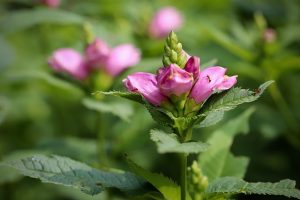In this guide, we’ve curated a list of remarkable wildflowers that you can grow. Let’s dig into the enchanting world of wildflowers to plant!
Purple Coneflower
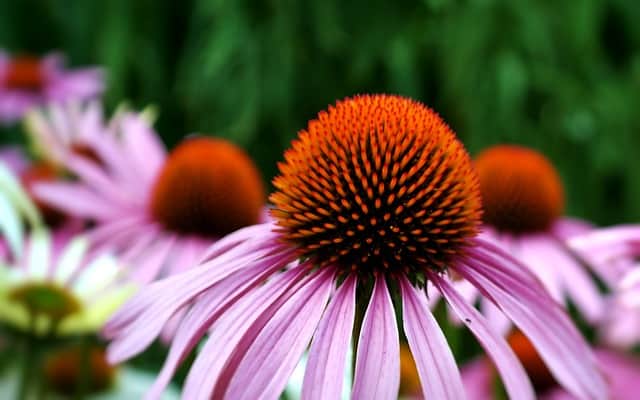
Echinacea purpurea, commonly known as Purple Coneflower, is a staple in wildflower gardens. This hardy perennial thrives in various soils and conditions, making it an excellent choice for both novice and experienced gardeners. With its striking, daisy-like purple petals and a prominent, spiky central cone, it adds both beauty and resilience to any garden.
Beyond aesthetics, Purple Coneflower is renowned for its medicinal properties, often used to boost the immune system or reduce symptoms of the common cold. Plant it in a sunny spot, and watch as it becomes a beloved gathering point for butterflies and bees, contributing to local pollinator populations.
Black-Eyed Susan
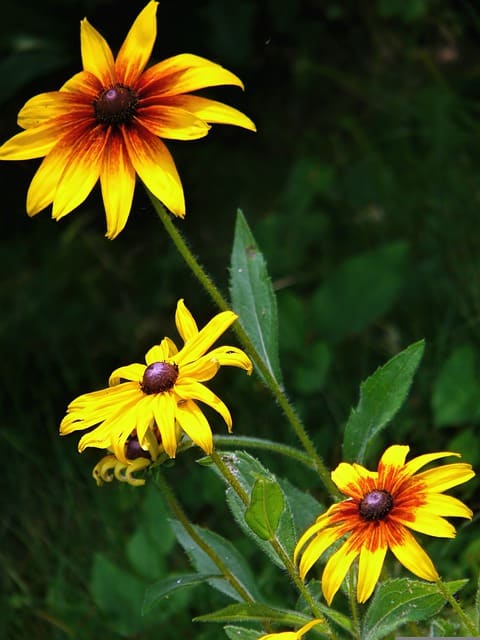
Rudbeckia hirta, or Black-Eyed Susan, is an iconic wildflower native to North America. Characterized by its golden yellow petals surrounding a dark brown center, this perennial is not just beautiful; it’s also incredibly hardy. Black-Eyed Susans are drought-resistant and flourish in poor soil, making them easy to grow and maintain.
Beyond its striking appearance, this wildflower plays a crucial role in supporting wildlife, attracting birds and insects alike. In late summer, the flowers provide sustenance for butterflies and other pollinators, while the seed heads offer food for birds like goldfinches in the fall.
Bee Balm

Monarda didyma, or Bee Balm, bursts forth in an array of colors—red, purple, and pink—making it a visually thrilling choice for garden spaces. Known for its culinary uses, it can also be brewed into a calming tea. Bee Balm attracts a wealth of pollinators, including bees, hummingbirds, and butterflies, making it an essential component in efforts to support declining insect populations.
This perennial prefers well-drained soil and partial to full sun. Beyond its ecological contributions, it offers a delightful aroma and vibrant blooms that can bring your garden to life.
Asters
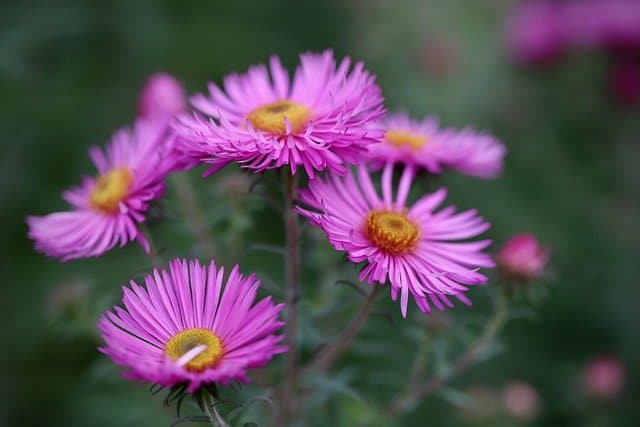
Asters are known for their vibrant fall blooms, providing texture and color when most other flowers are fading. With various species available, Asters can range in height from low-growing ground covers to tall, stately plants. They thrive in full sun to partial shade and are adaptable to a range of soil types, often found in meadows and open woodlands.
Aster flowers provide vital late-season food for pollinators, including monarchs and honeybees. Their star-shaped blooms not only attract these creatures but also offer a breathtaking display in late summer and autumn gardens.
Goldenrod
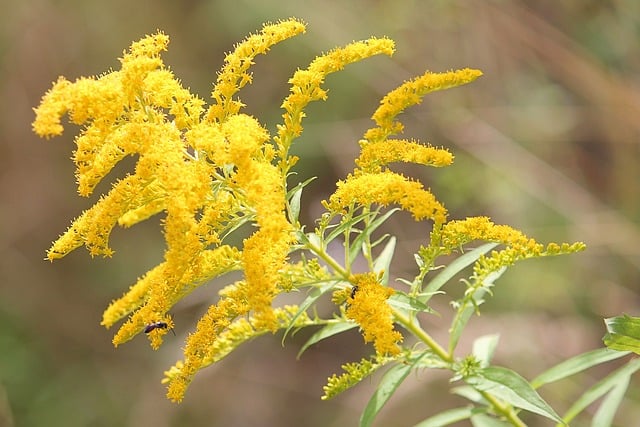
Solidago spp., commonly known as Goldenrod, often gets a bad rap for causing allergies, but the flowering plant is a vital resource for pollinators. With its characteristic tall, golden plumes, it brightens late summer landscapes. Goldenrod thrives in various soil types and is a great choice for a low-maintenance garden.
Rich in nectar, Goldenrod attracts butterflies and a wide range of bees that rely on its blossoms during the late growing season. Additionally, its golden flowers can act as a natural insect repellent, adding an extra layer of benefit.
Blazing Star
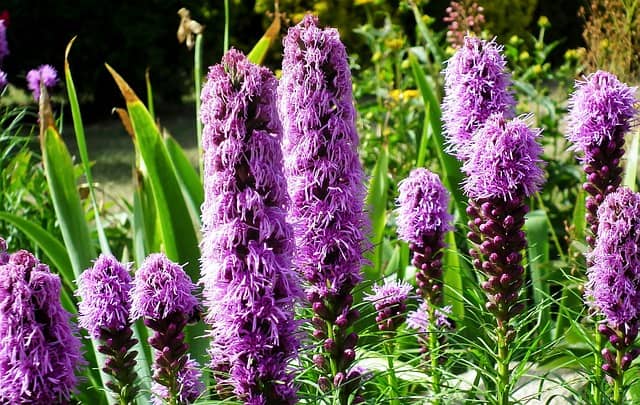
Liatris spp., popularly known as Blazing Star, is a striking wildflower with tall spikes of purple blooms. These flowers are not only visually captivating but also attract butterflies and bees. Blazing Star thrives in well-drained soils and full sun, making them easy to incorporate into a sunny wildflower garden.
What sets Blazing Star apart is its unique flowering pattern, where lower flowers bloom first, creating a captivating cascading effect. This perennial also makes for excellent cut flowers, bringing wild beauty indoors.
Joe-Pye Weed
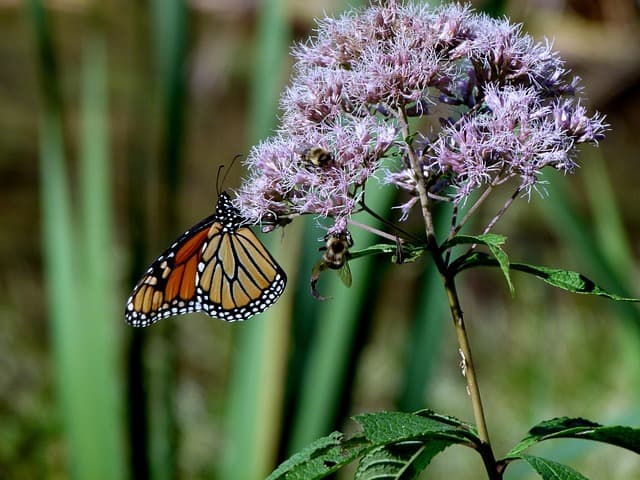
Eutrochium purpureum, or Joe-Pye Weed, is a magnificent perennial that adds height and drama to your garden. With clusters of fluffy pink to mauve flowers that bloom in late summer, it’s a key nectar source for pollinators such as butterflies and bees. This robust plant prefers moist soils and can often be found growing naturally in wetland areas.
Joe-Pye Weed is named after a Native American herbalist and has a history of medicinal use. Beyond its allure for pollinators, it offers privacy and structure, making it ideal for back borders or hidden garden corners.
Lupine

Lupinus spp., or Lupine, is celebrated for its vibrant, tall flower spikes, which bloom in an array of colors, including purple, blue, and pink. Often found in disturbed soils and meadows, Lupines are nitrogen-fixing plants, enriching the soil they grow in, thus benefitting neighboring plants.
This perennial thrives in well-drained soils and provides an essential habitat for larvae of specific butterflies. Their unique blooms make them a delight for both bees and gardeners, offering a bold statement in any wildflower collection.
Butterfly Weed

Asclepias tuberosa, known as Butterfly Weed, is another member of the Milkweed family, prized for its striking orange flowers. This perennial is a beacon for pollinators, especially butterflies, making it a must-have for butterfly gardens. It thrives in well-drained soils and tolerates drought conditions better than many other wildflowers.
In addition to its beauty and insect-attracting properties, Butterfly Weed creates a lively atmosphere in gardens, providing a cheerful burst of color when many other flowers have finished blooming.
New England Aster

Symphyotrichum novae-angliae, or New England Aster, is a stunning addition to any garden, known for its large, vibrant purple flowers that bloom in late summer to fall. This perennial thrives in full to partial sun and prefers moist soils, making it perfect for border gardens and wildflower meadows.
New England Aster is particularly valuable for pollinators, offering nectar when many other flowers are in decline. This plant also adds a rich dimension to garden landscapes, dramatically changing the palette as summer fades into autumn.
Coreopsis
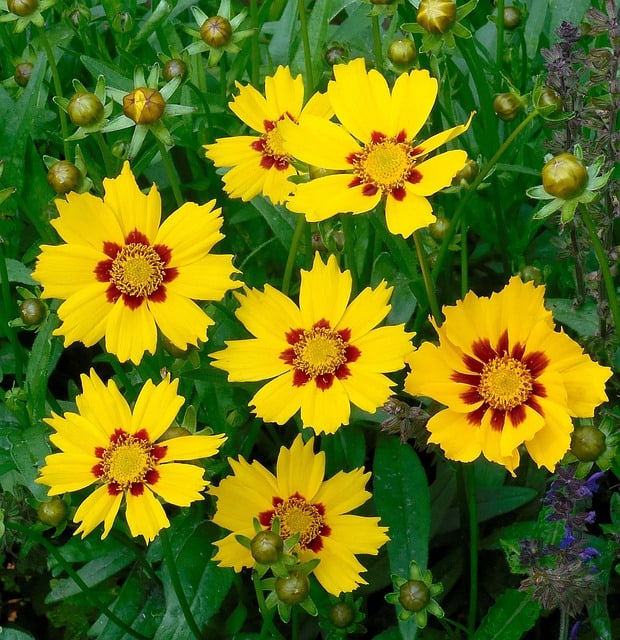
Coreopsis spp. are often recognized for their bright yellow blooms, making them a cheerful garden choice. These perennials, also known as Tickseed, are easy to grow and maintain, thriving in full sun and well-drained soils. Their daisy-like flowers bloom throughout summer, attracting butterflies and other pollinators to your garden.
With species ranging from low-growing ground covers to taller varieties, Coreopsis is versatile and can suit a variety of landscaping needs. Their long blooming period extends the color palette of your garden and the region’s aesthetics.
Columbine
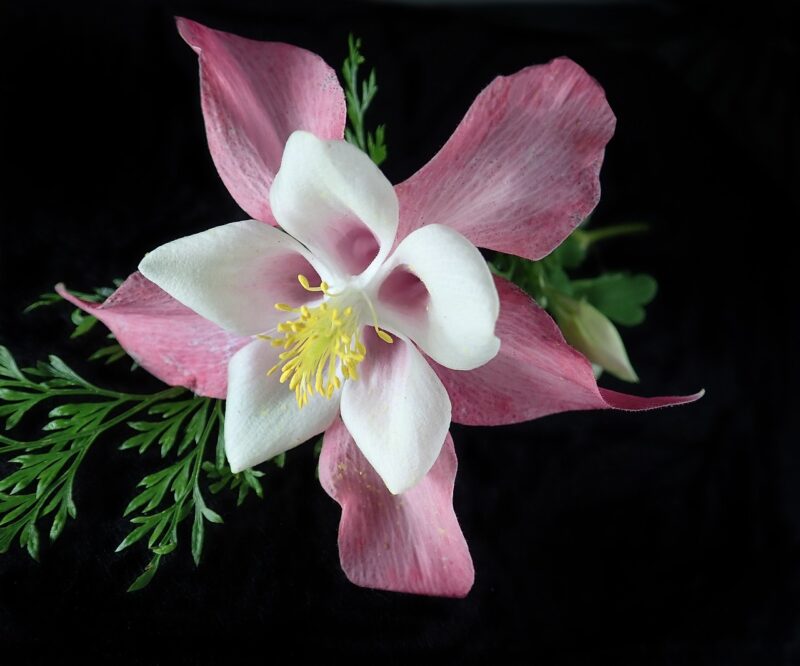
Aquilegia spp., or Columbine, is a charming perennial known for its unique, bell-shaped flowers. With a variety of colors, including blue, red, and yellow, Columbines are a delightful addition to shaded garden areas or woodland gardens. They thrive in moist, well-drained soils and can grow in full sun to partial shade.
Columbine flowers are especially attractive to hummingbirds and bumblebees, making them excellent choices for creating a wildlife-friendly habitat. This delicate flower not only adds beauty to your garden but also encourages biodiversity.
Wild Indigo
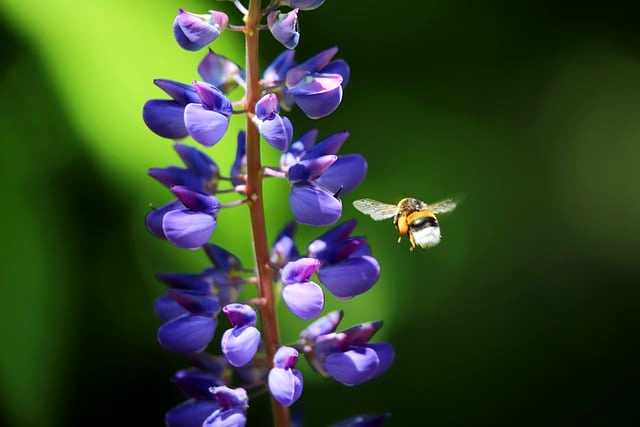
Baptisia spp., frequently referred to as Wild Indigo, carries striking blue flowers atop tall, bushy plants. These perennials are highly adaptable, thriving in a variety of soil types, and are particularly well-suited for regions with less fertile conditions. Wild Indigo is not only beautiful but also fixes nitrogen in the soil, contributing to soil health.
Moreover, its flowers attract bees and other pollinators, enriching your garden’s ecosystem. With its strong presence and colorful blooms, Wild Indigo creates a captivating scene in garden landscapes.
Wild Blue Phlox

Phlox divaricata, or Wild Blue Phlox, is a beloved blue-flowered perennial that brings color and fragrance to shady areas. Known for its soft beauty and sweet scent, this wildflower flourishes in moist, well-drained soils and full to partial shade.
With a delightful quality that draws butterflies and bees, Wild Blue Phlox is perfect for naturalistic gardens, woodland gardens, or as ground cover in lawns. Its spreading habit offers great visual appeal, while it remains low maintenance.
California Poppy
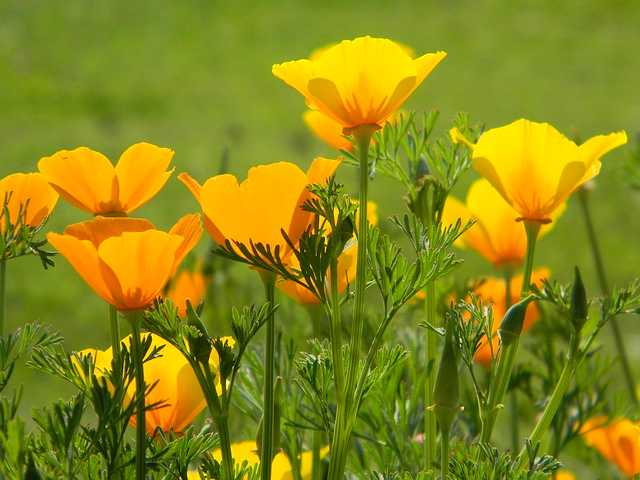
Eschscholzia californica, the California Poppy, dazzles with its bright orange and yellow flowers. Native to California and a variety of nearby states, this annual thrives in well-drained soils and full sun, making it an excellent choice for sunny borders or wildflower patches.
These poppies are not just stunning; they’re also drought-tolerant, making them a perfect low-maintenance option for gardens in arid climates. The California Poppy also attracts pollinators, creating a lively and vibrant outdoor space.
Penstemon
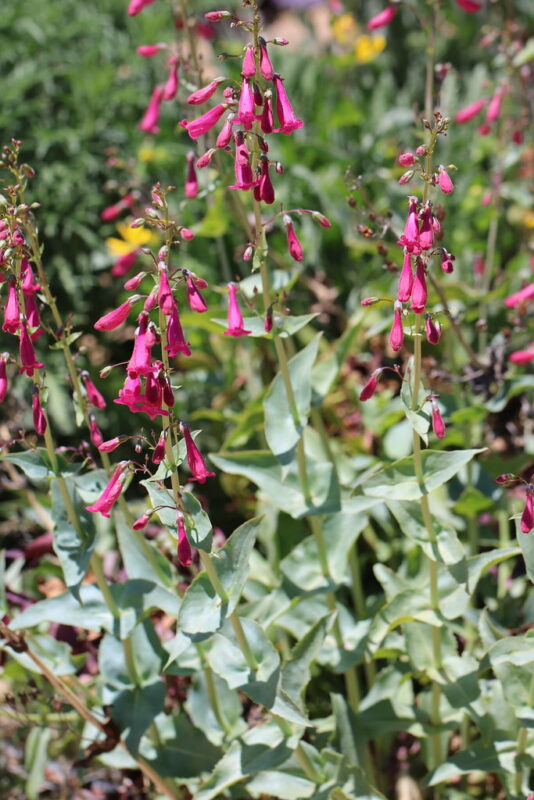
Penstemon spp., known as Beardtongue, is characterized by its tubular flowers that come in shades of purple, red, and blue. These perennials thrive in rocky, well-drained soils and full sun, making them suitable for wildflower gardens and natural landscaping.
Penstemons are a favorite among hummingbirds and other pollinators, making them a great choice for creating an active wildlife haven. Their unique shapes and colors add diversity to garden design, while their drought tolerance ensures they remain resilient throughout various seasons.
Sunflower
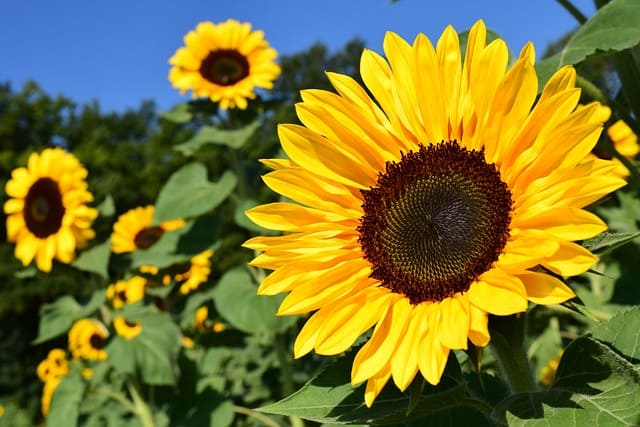
Helianthus annuus, the classic Sunflower, is a beacon of summer with its tall stalks and large, cheerful blooms. Sunflowers are easy to grow, thrive in nearly any soil type, and prefer full sun. They can reach impressive heights and are favored for their stunning aesthetics and ability to attract pollinators.
Additionally, sunflowers produce seeds that feed birds and other wildlife, making them a functional choice for gardens focused on wildlife conservation. Their towering structure provides vertical interest and can help screen unwanted views.
Oxeye Daisy (Leucanthemum vulgare)

Leucanthemum vulgare, commonly known as Oxeye Daisy, is a classic wildflower that easily adapts to various environments. With its white petals and yellow center, it captures the essence of traditional gardens. This perennial thrives in full sun to partial shade and can flourish in diverse soil conditions.
Oxeye Daisies are especially attractive to pollinators and can become a vibrant feature in meadows or borders. Their simple beauty and ease of growth make them a popular choice for wildflower gardens.
Wild Strawberry (Fragaria vesca)
Fragaria vesca, or Wild Strawberry, is a charming perennial that produces delicious, small fruits. Ideal for partially shaded areas, it thrives in well-drained soil and can spread readily, making it excellent as ground cover. The white blossoms not only provide beauty but also attract pollinators.
Growing Wild Strawberries not only adds unique foliage and fruits to your garden bed but also supports local wildlife, as their flowers draw bees and other beneficial insects. Their sweet fruits make them a joyful treasure for gardeners and wildlife alike.
Borage

Borago officinalis, or Borage, is a delightful addition with its star-shaped blue flowers and fuzzy foliage. This annual herb is easy to grow, thriving in full sun. Borage is renowned for attracting bees, and its flowers are even edible—often used as a garnish or in salads.
Besides its aesthetic appeal, Borage has beneficial properties for the garden. It improves the soil quality by breaking up compacted earth and can be used as a companion plant for crops such as strawberries and tomatoes, enhancing their growth.
Yarrow

Achillea millefolium, commonly known as Yarrow, is a resilient perennial that adds hardy charm to wildflower gardens. Known for its feathery foliage and clusters of small, flat-topped flowers ranging from white to vibrant yellow, Yarrow grows well in drought-prone areas and poor soils.
This perennial not only attracts beneficial insects and pollinators but has a longstanding tradition as a medicinal herb. Yarrow can be easily incorporated as ground cover or in borders, where its airy appearance can soften hard lines.
Cardinal Flower
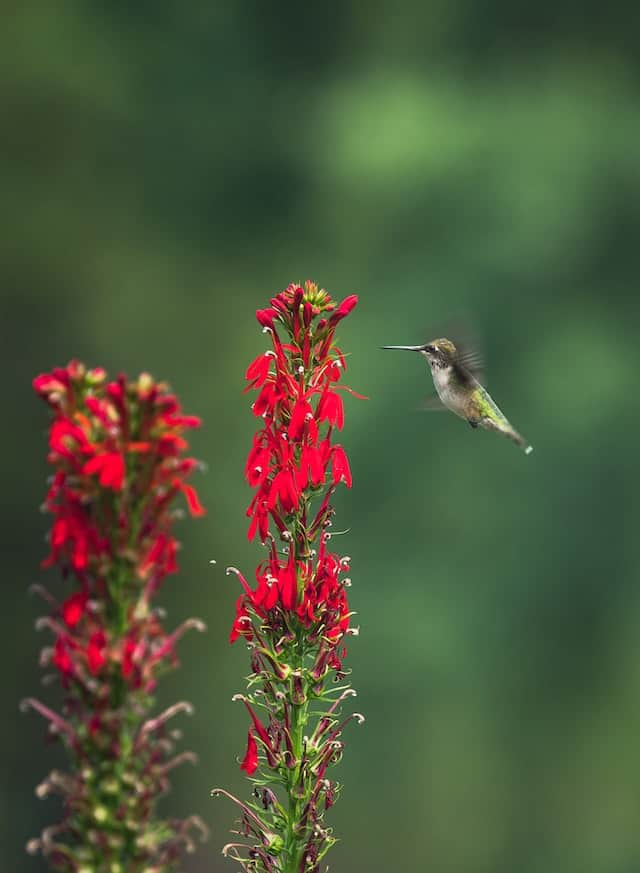
Lobelia cardinalis, or Cardinal Flower, is a striking perennial celebrated for its tall, fiery red blooms. This wildflower thrives in moist, shady areas and is often found near waterways and wetlands. Its vibrant color makes it a stunning focal point in any garden.
Cardinal Flowers are particularly appealing to hummingbirds and butterflies, who flock to their nectar-rich blooms. By incorporating this beauty into your garden, you’re not only enhancing its aesthetics but also providing a vital food source for avian visitors.
Purple Prairie Clover (Dalea purpurea)

Dalea purpurea, the Purple Prairie Clover, is a stunning native wildflower characterized by its purple spikes of blossoms. It thrives in well-drained soil and full sun, making it a resilient addition to any garden. This perennial attracts a variety of pollinators due to its high nectar content.
Beyond its beauty, the Purple Prairie Clover fixes nitrogen in the soil, making it an essential plant for improving soil health. It is an excellent choice for prairie restoration projects and native gardens, helping to sustain local biodiversity.
Echinacea
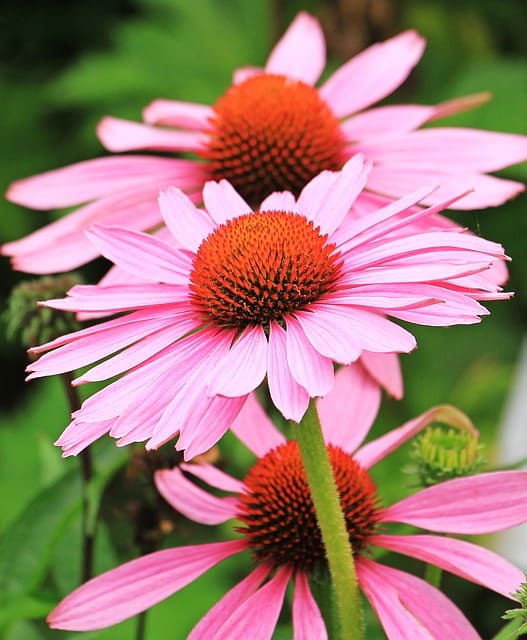
Similar to the earlier mentioned Purple Coneflower, Echinacea, or Coneflower, represents resilience with its striking blooms and health benefits. This wildflower is known for its medicinal properties, widely used to promote wellness, particularly for respiratory health.
Echinacea varieties come in an assortment of colors, making them a dynamic choice for garden beds. The plant thrives in a variety of soils and is highly attractive to pollinators throughout the growing season.
Spiderwort
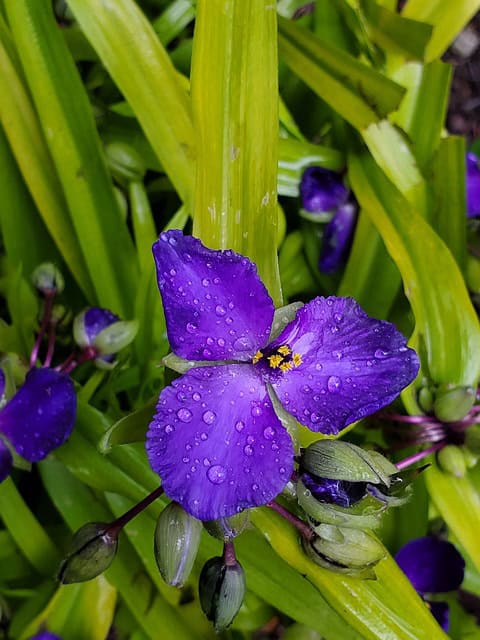
Tradescantia spp., or Spiderwort, is known for its lush foliage and vibrant three-petaled flowers that can range from blue to purple. These perennials thrive in moist, well-drained soils and prefer areas with partial shade; they are perfect for naturalized areas of the garden.
Spiderwort’s visually appealing spreading habit makes them ideal for ground cover, filling in spaces beautifully. They also attract bees and butterflies, encouraging a diverse array of wildlife in your outdoor space.
Wild Rose

Rosa spp., the Wild Rose, is a cherished addition, with its delicate pink and white blooms. These perennial shrubs thrive in various soil conditions and are often found in meadows and woodland edges. Wild Roses are not only beautiful but produce hips that provide essential food for wildlife in the fall.
In addition to contributing to habitat diversity, their fragrance and luscious flowers create a romantic atmosphere in any garden. Gardeners appreciate their low maintenance, making them an ideal choice for naturalized gardens.
Gaillardia

Gaillardia, or Blanket Flower, is known for its bold, warm colors ranging from reds to yellows. This annual to perennial plant brings bright blossoms that bloom all summer long, attracting an array of pollinators. Gaillardia tolerates poor soils, dry conditions, and full sun.
Its long blooming period adds a vibrant touch to any garden, while its resilience makes it a popular selection for gardeners seeking low-maintenance wildflowers. The cheerful blooms not only provide aesthetic appeal but also enrich habitat for local wildlife.
Wild Geranium
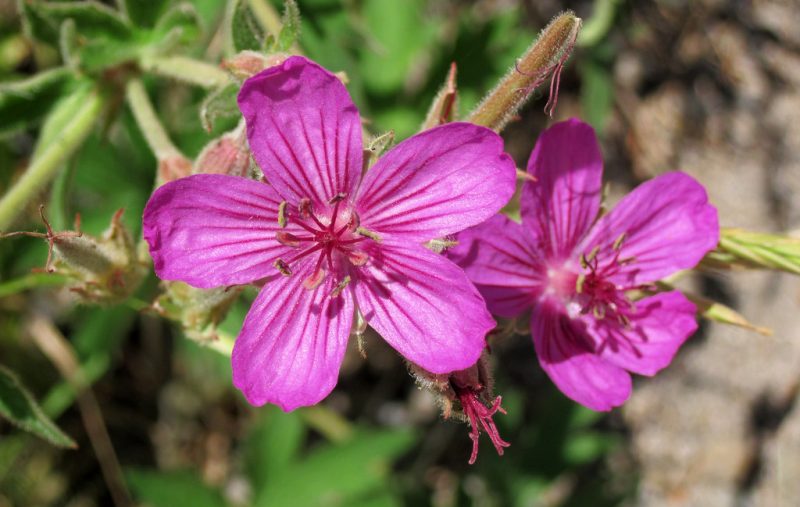
Geranium maculatum, or Wild Geranium, is a stunning perennial with lovely pink flowers and attractive foliage. This wildflower thrives in shaded areas and moist to average soils, making it a great choice for woodland gardens or shady borders.
Wild Geranium attracts a variety of pollinators, providing resources for bees and butterflies. The delicate blooms add a soft touch to garden settings, enhancing the naturalistic feel of any landscape.
Golden Alexanders (Zizia aurea)

Zizia aurea, known as Golden Alexanders, features clusters of small, bright yellow flowers that bloom in spring. This perennial thrives in moist, rich soils and is often found in woodland edges and meadows. Known for attracting early-season pollinators, Golden Alexanders are particularly important for supporting insect populations emerging in spring.
These wildflowers can spread readily, providing a lush carpet of yellow in your garden. Their charming flowers and attractive foliage make them both a practical and aesthetically pleasing addition to any wildflower collection.
Mountain Mint
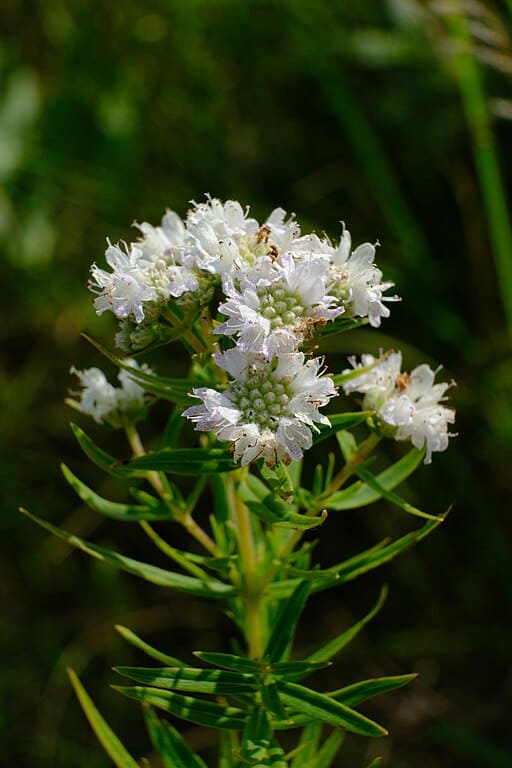
Pycnanthemum spp., or Mountain Mint, captures the senses with its fragrant leaves and clusters of small white flowers. It grows well in sunny to partially shaded areas, in soils that are well-draining. Native to various regions, Mountain Mint attracts pollinators while repelling certain pests, creating a natural balance in the garden.
The plant’s unique fragrance makes it not only a beautiful addition but also a naturally aromatic one. It can thrive in wildflower gardens and edges, inviting essential wildlife while providing an earthy presence in your landscape.
Wild Senna (Senna hebecarpa)

Senna hebecarpa, or Wild Senna, is known for its attractive yellow flowers that bloom from late summer to fall. This native perennial thrives in rich, moist soils and can often be found in meadows and along roadsides. Wild Senna is important for wildlife, particularly caterpillars of specific butterflies, which rely on it for food.
This perennial’s shrubby habit provides structure to the garden and an inviting habitat for pollinators. Integrating Wild Senna into your garden offers both visual appeal and biodiversity enhancement.
Culver’s Root

Veronicastrum virginicum, or Culver’s Root, is a tall perennial with unique, spiked flowers that bloom in shades of white to lavender. This eye-catching plant thrives in moist, well-drained soils and full sun to partial shade. With its erect stature, Culver’s Root can add drama and height to your garden areas.
In addition to its striking appearance, this perennial serves as an important nectar source for pollinators during the summer months. Cultivating Culver’s Root in your wildflower garden not only enhances its beauty but also enriches the life cycle of local wildlife.
Blue Vervain

Verbena hastata, or Blue Vervain, is a graceful perennial celebrated for its tall spikes of small, blue-purple flowers. Growing in moist soils, it flourishes in sunny areas or partial shade, bringing a lovely vertical element to your garden. Blue Vervain attracts butterflies, bees, and other pollinators, making it a fantastic choice for creating habitats.
This wildflower contributes to the diverse landscape of any garden, drawing attention to pollinator activity throughout the seasons. Its elegant form and nectar-rich blooms will surely captivate anyone who walks through your space.




